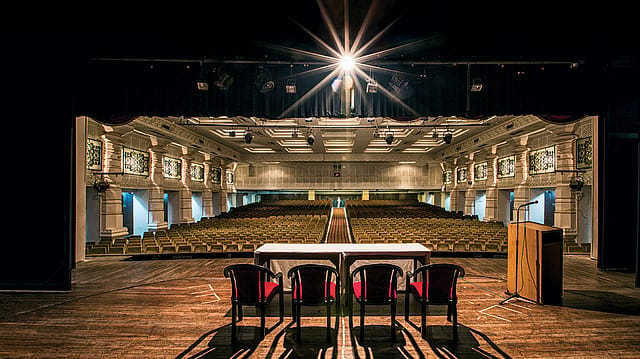Hall of fame
ADVERTISEMENT

For more than half a century, the directors of some of India’s largest corporations have been making an annual trip to the basement of a nondescript building in Mumbai’s New Marine Lines. The Birla Matoshree Sabhagar, a 1,075-seater auditorium, has hosted more than 1,500 annual general meetings (AGM) since its inception in 1958. Twenty-two companies on this year’s Fortune India 500, with a combined market capitalisation of nearly Rs 19 lakh crore, have met their shareholders at Birla Matoshree in the past three years.
If there were ever a single location that has witnessed corporate India’s biggest announcements, this would be it. According to an old-time Parsi shareholder of Tata Motors (Fortune India rank 5), it was here in 1991 that former chairman J.R.D. Tata pleaded with his shareholders to let his successor Ratan Tata make a people’s car.
Dhirubhai Ambani, the founder of Reliance Industries (Fortune India 500 rank 2), announced the company’s first 1:1 bonus issue at the 1997 AGM. His son Mukesh, in his first AGM as the company’s new chairman and managing director, announced that Reliance had discovered natural gas in the very first well it drilled in the Krishna-Godavari basin.
January 2026
Netflix, which has been in India for a decade, has successfully struck a balance between high-class premium content and pricing that attracts a range of customers. Find out how the U.S. streaming giant evolved in India, plus an exclusive interview with CEO Ted Sarandos. Also read about the Best Investments for 2026, and how rising growth and easing inflation will come in handy for finance minister Nirmala Sitharaman as she prepares Budget 2026.
Old associates recall Reliance executives constructing a temporary lift for Dhirubhai Ambani to enable him to chair a meeting after a stroke restricted his movement. One of them says J.R.D. Tata used to bring a clock to keep track of the AGM’s pace.
There have been some confrontations at the auditorium too. During a 400-day hunger strike at Voltas three years ago, labour union members filled the auditorium staging a protest. “Usually some employees are permitted to attend an AGM but the management allowed the union members in because tensions were high at the time,” says an old auditorium hand.
Though the Reliance AGM is the biggest show of the year at Birla Matoshree—the attendance exceeds 2,000—it was the Birlas (of course) who began conducting AGMs at the auditorium in the 1960s. Damodar Bindal, management consultant at Birla Matoshree, says, “Then the Tatas started holding their meetings here. Dhirubhai started holding AGMs at the Brabourne Stadium but moved here after the first few.”
While five Tata Group companies—Tata Consultancy Services, Tata Motors, Tata Steel, Tata Power, and Tata Chemicals—still hold their AGMs here, all Aditya Birla Group companies, except UltraTech Cement, have moved to other auditoriums. Bindal says that’s because they don’t need a hall as large as Matoshree. More than 25% of the auditorium’s income comes from AGMs, although it hosts more than 300 events annually. “AGM rentals are around 1.5 lakh whereas a cultural programme would bring about Rs 30,000. AGMs need longer preparation, and companies usually hire the place from the previous evening,” says Bindal.
Owned by the Bombay Hospital Trust, Birla Matoshree was built by Rameshwar Das Birla, the older brother of Ghanshyam Das Birla, the founder of one of India’s oldest business empires. Trust chairman Bharat Taparia says all surplus income from the auditorium goes to the Bombay Hospital as charity. Built in the memory of Rameshwar Das Birla’s mother, the auditorium stands on columns and has a revolving stage—an unusual feature when it was built in the 1950s. Birla hired Mumbai-based architects Patki & Dadarkar for the job. “The original switchboard still exists. We’ve not replaced a single part,” says Jayesh Dattani, a member of Bindal’s team. Dattani recalls that the hall was back in business in three weeks even when fires broke out in 1967 and 1972.
Besides AGMs, typically held from June to August, and cultural programmes, the auditorium is used for community events and condolence meetings. Dattani recalls magicians P.C. Sorcar and K. Lal booking the hall for months in the 1980s. Bindal says another famous visitor was Dr Christiaan Barnard, who carried out the world’s first successful human-to-human heart transplant, and had come to head a conference at the auditorium. The centenary celebrations of the Indian National Congress were held there in 1985, with Rajiv Gandhi leading the proceedings. In the auditorium’s archives are original recordings of performances by shehnai maestro Bismillah Khan, qawwali duo the Sabri Brothers, and tabla legends Alla Rakha and Zakir Hussain. “The faux ceilings and pillars are conducive to great acoustics,” says Bindal.
